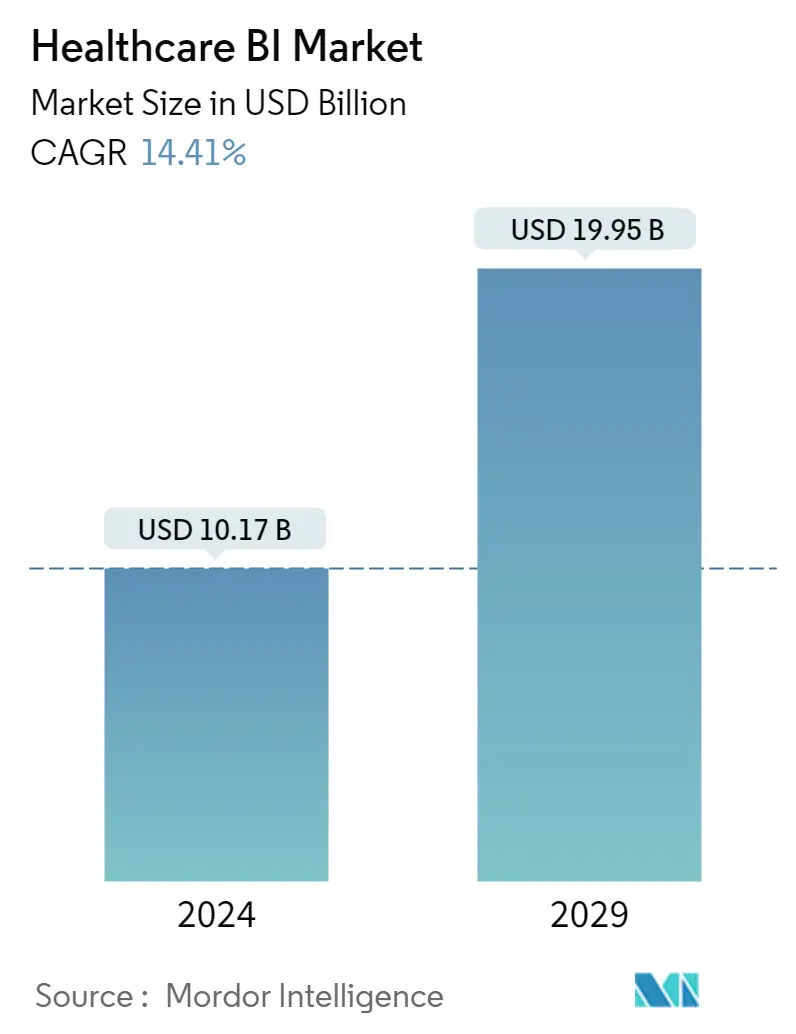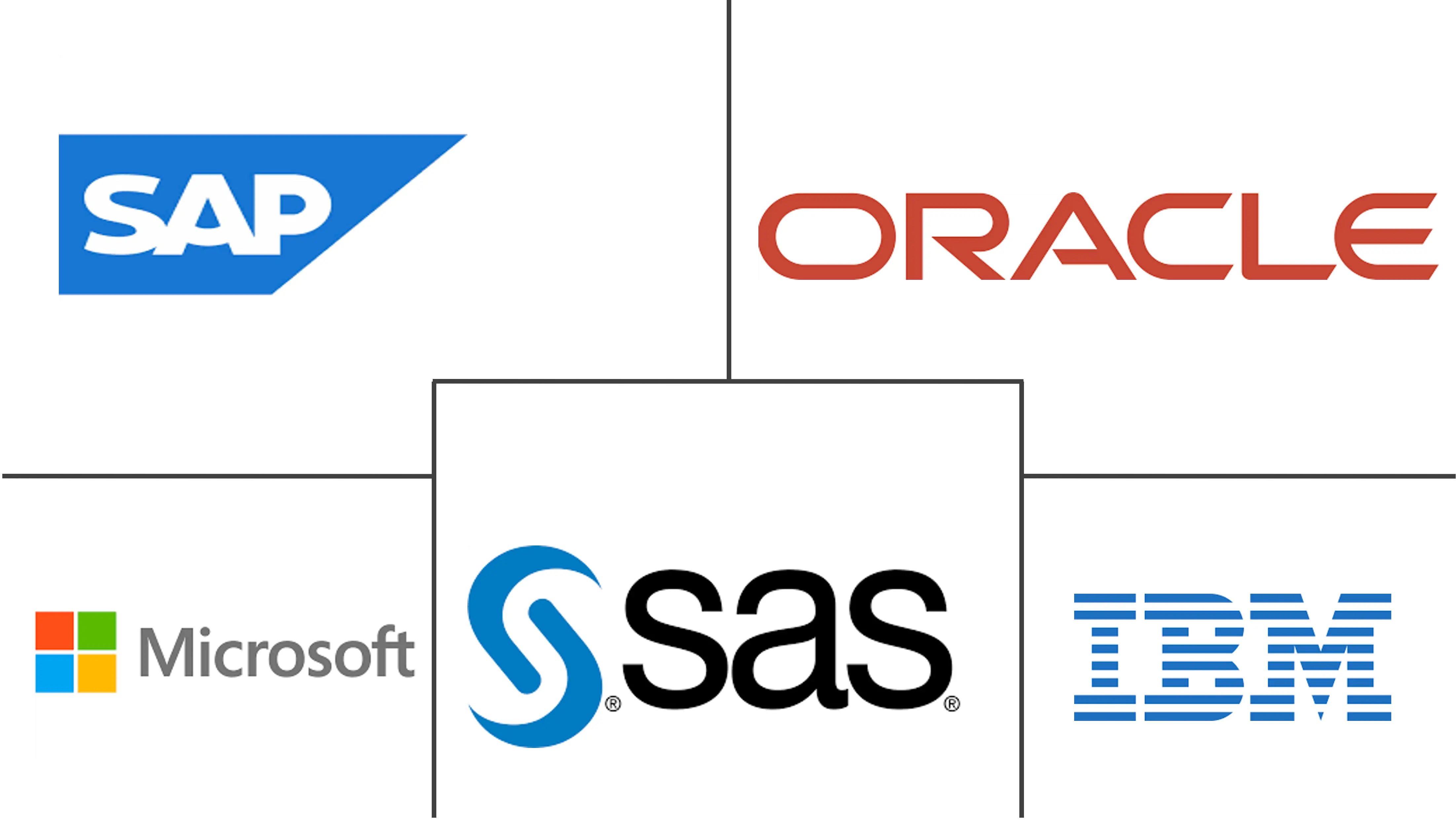Market Size of Healthcare BI Industry

| Study Period | 2021 - 2029 |
| Market Size (2024) | USD 10.17 Billion |
| Market Size (2029) | USD 19.95 Billion |
| CAGR (2024 - 2029) | 14.41 % |
| Fastest Growing Market | Asia Pacific |
| Largest Market | North America |
Major Players
*Disclaimer: Major Players sorted in no particular order |
Healthcare BI Market Analysis
The Healthcare BI Market size is estimated at USD 10.17 billion in 2024, and is expected to reach USD 19.95 billion by 2029, growing at a CAGR of 14.41% during the forecast period (2024-2029).
The COVID-19 outbreak demonstrated the effects of public health crises on emergency departments and hospital systems. In recent years, frontline healthcare facilities have demonstrated how to effectively manage limited assets using data analytics and applications. COVID-19 data was collected by workers at outbreak sites, including transmissibility, risk factors, incubation period, and mortality rate. This information creates visualizations, mathematical models, and neural network training. For example, according to a study published by Elsevier in February 2022, a study was conducted which showed that digital technology adoption in Europe jumped from 81% to 95% during the pandemic. BI applied to emergency medical services (EMS) has proven extremely beneficial in improving pandemic management and speeding up the outbreak response decision-making process. Hence, the studied market was significantly impacted by the COVID-19 pandemic. However, as the pandemic has subsided, the market is expected to lose some tractions, but it is expected to have healthy growth during the forecast period.
In the software-as-a-service market, business intelligence is becoming increasingly well-funded. BI promises to help identify, develop, and otherwise create new revenue opportunities by handling large amounts of data to analyze and benchmark lines of business. The increasing number of patient registries is a major factor driving the growth of the market. For instance, according to an article published by Frontiers in August 2022, patient registries are considered an important source of data for healthcare practices, drug utilization, and clinical outcomes. These registries help in addressing various challenges by providing information on epidemiology, standards of care, and treatment patterns of rare diseases, among others. Hence, the advantages of patient registries are expected to increase the usage of patient registries, thereby increasing the adoption of health business intelligence.
The healthcare BI market will show rapid growth due to government initiatives to increase EHR adoption and the number of patient registries, and the emergence of big data in the healthcare industry. As per the article published by the Biomedical Journal of Scientific & Technical Research in January 2021, the Government of India focused on digitizing its healthcare, including Electronic Health Records (EHR), to provide better patient data management, seamless coordination between healthcare providers, and improved healthcare research. Several national-level policies, such as National Digital Health Blueprint, are being formulated to create a pan-India digital health record system. As per the same source, at the provider level, large health systems like Tata Memorial Hospital and Max Hospitals Private Limited have implemented electronic medical record (EMR) systems and are moving toward EHR. Hence, the benefits associated with the BI and its increasing adoption rate across the healthcare industry are driving the market growth. However, the complexity of systems may hinder market growth over the forecast period.
Healthcare BI Industry Segmentation
As per the scope of the report, healthcare business intelligence (BI) is the process by which large-scale data from the massive healthcare industry can be collected and refined into actionable insights. Healthcare BI aggregates and analyzes different types of healthcare data, including traditional records such as medical history and financial data, along with unstructured data gathered from the web and the internet of medical things.
The Healthcare BI Market is Segmented by Component (Software and Services), Mode of Delivery (On-Premise Model, Hybrid Model, and Cloud-Based Model), Application (Financial Analysis, Clinical Data Analysis, Patient Care Analysis, and Other Applications), End User ( Payers, Healthcare Providers, and Other End Users), and Geography (North America, Europe, Asia-Pacific, Middle-East and Africa, and South America). The report offers the value (in USD million) for the above segments.
| By Component | |
| Software | |
| Services |
| By Mode of Delivery | |
| On-premise Model | |
| Hybrid Model | |
| Cloud-based Model |
| By Application | |
| Financial Analysis | |
| Clinical Data Analysis | |
| Patient Care Analysis | |
| Other Applications |
| By End User | |
| Payers | |
| Healthcare Providers | |
| Other End Users |
| Geography | ||||||||
| ||||||||
| ||||||||
| ||||||||
| ||||||||
|
Healthcare BI Market Size Summary
The healthcare business intelligence market is poised for significant growth, driven by the increasing adoption of digital technologies and data analytics in the healthcare sector. The COVID-19 pandemic highlighted the critical role of business intelligence in managing public health crises, leading to a surge in digital technology adoption. This has resulted in enhanced data collection and analysis capabilities, which are crucial for improving patient care and operational efficiency. The market is further bolstered by the growing number of patient registries, which provide valuable data for healthcare practices and clinical outcomes. These registries are instrumental in addressing challenges related to epidemiology, standards of care, and treatment patterns, thereby fostering the adoption of healthcare business intelligence solutions.
The market's expansion is also supported by government initiatives to increase electronic health record (EHR) adoption and the emergence of big data in healthcare. Cloud-based business intelligence tools are gaining traction due to their agility, cost-effectiveness, and user-friendly nature, which surpass traditional on-premise models. The introduction of innovative products, such as Snowflake's cloud-based data-sharing platform and Microsoft's Azure Health Data Services, further propels market growth. North America leads the global market, driven by the high adoption rate of EHRs and the integration of advanced data services in healthcare. The competitive landscape is marked by major players like Oracle, Microsoft, and IBM, who are actively engaging in product innovation and strategic acquisitions to enhance their market presence.
Healthcare BI Market Size - Table of Contents
-
1. MARKET DYNAMICS
-
1.1 Market Overview
-
1.2 Market Drivers
-
1.2.1 Growing Government Initiatives for Healthcare Digitalization, Like Adoption of EHR
-
1.2.2 Increasing Number of Patient Registries
-
1.2.3 The Emergence of Big Data in the Healthcare Industry
-
-
1.3 Market Restraints
-
1.3.1 High Cost of Implementation
-
1.3.2 Lack of Skilled Professionals
-
-
1.4 Porter's Five Forces Analysis
-
1.4.1 Threat of New Entrants
-
1.4.2 Bargaining Power of Buyers/Consumers
-
1.4.3 Bargaining Power of Suppliers
-
1.4.4 Threat of Substitute Products
-
1.4.5 Intensity of Competitive Rivalry
-
-
-
2. MARKET SEGMENTATION (Market Size by Value - USD million)
-
2.1 By Component
-
2.1.1 Software
-
2.1.2 Services
-
-
2.2 By Mode of Delivery
-
2.2.1 On-premise Model
-
2.2.2 Hybrid Model
-
2.2.3 Cloud-based Model
-
-
2.3 By Application
-
2.3.1 Financial Analysis
-
2.3.2 Clinical Data Analysis
-
2.3.3 Patient Care Analysis
-
2.3.4 Other Applications
-
-
2.4 By End User
-
2.4.1 Payers
-
2.4.2 Healthcare Providers
-
2.4.3 Other End Users
-
-
2.5 Geography
-
2.5.1 North America
-
2.5.1.1 United States
-
2.5.1.2 Canada
-
2.5.1.3 Mexico
-
-
2.5.2 Europe
-
2.5.2.1 Germany
-
2.5.2.2 United Kingdom
-
2.5.2.3 France
-
2.5.2.4 Italy
-
2.5.2.5 Spain
-
2.5.2.6 Rest of Europe
-
-
2.5.3 Asia-Pacific
-
2.5.3.1 China
-
2.5.3.2 Japan
-
2.5.3.3 India
-
2.5.3.4 Australia
-
2.5.3.5 South Korea
-
2.5.3.6 Rest of Asia-Pacific
-
-
2.5.4 Middle-East and Africa
-
2.5.4.1 GCC
-
2.5.4.2 South Africa
-
2.5.4.3 Rest of Middle-East and Africa
-
-
2.5.5 South America
-
2.5.5.1 Brazil
-
2.5.5.2 Argentina
-
2.5.5.3 Rest of South America
-
-
-
Healthcare BI Market Size FAQs
How big is the Healthcare BI Market?
The Healthcare BI Market size is expected to reach USD 10.17 billion in 2024 and grow at a CAGR of 14.41% to reach USD 19.95 billion by 2029.
What is the current Healthcare BI Market size?
In 2024, the Healthcare BI Market size is expected to reach USD 10.17 billion.

